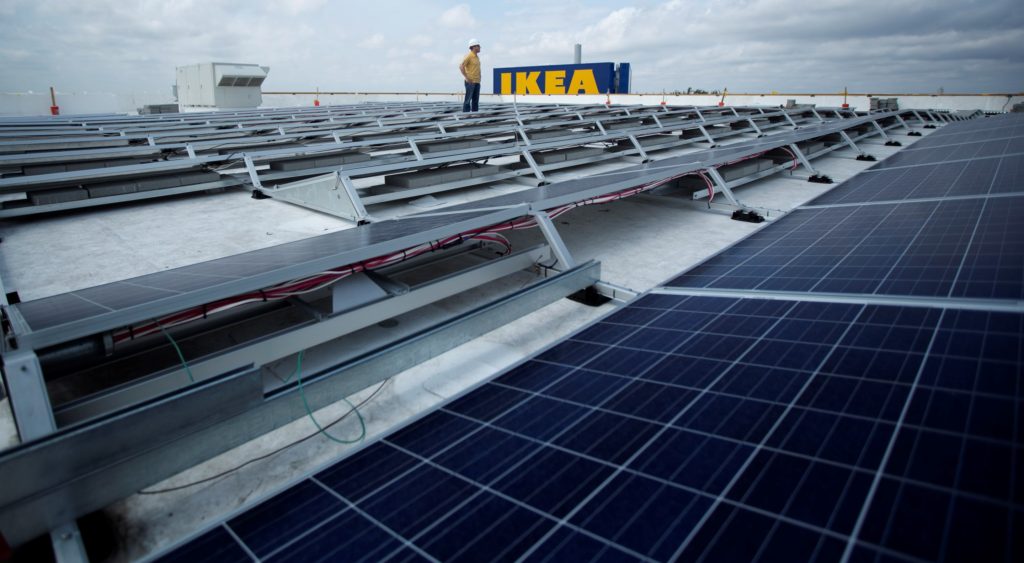Solar energy is becoming more diverse than rooftop panels on houses. It has become a consistent source of innovation in the U.S., guiding the flow of research dollars and policies that even the Trump administration can’t seem to dodge — and is even embracing.President Trump went as far as suggesting the idea of integrating solar panels into his border wall with Mexico after reportedly cribbing it from Las Vegas architect Thomas Gleason.Gleason’s architecture firm submitted a proposed solar border fence to the Department of Homeland Security, telling Business Insider that he had been batting around the idea “for months” and knew a few people in contact with Trump who could get the proposal in front of the president.
Gleason said the wall would take about 20 years to build, but it wouldn’t be able to generate stable amounts of electricity. The Mexican border is far from a straight line, and light intensity changes from month to month, which could complicate his calculations. Gleason said his company hasn’t received the go-ahead from the federal government to conduct a full evaluation of the plan.
One of the big drawbacks to solar is its intermittency, since solar panels generate electricity only when the sun is shining. There are exceptions, such as big solar thermal plants. But those are utility-scale projects the size of small towns. Typically, smaller solar cells on a single-family home, for example, cannot generate energy when the sun goes down.
Much of the money being spent on research is aimed at solving those fundamental problems with solar electricity, with companies all over the world pushing new technologies to make solar more reliable and cheaper.
Here are seven things you didn’t know about where solar energy is headed:
- Prince of solar

Before his death, Prince quietly funneled millions of dollars into solar energy research. (AP Photo)
Solar energy received a lot of support from the late music icon Prince, according to Van Jones, former President Barack Obama’s former green jobs adviser and a CNN commentator.
Before his death, Prince had been quietly funneling millions of dollars into solar energy research. By the time he died in April 2016, Prince had contributed $25 million. He was sending the millions to a for-profit investor group called Powerhouse that connects solar energy entrepreneurs to investors.
Prince sought out Jones when he was still working in the Obama White House to understand how he could support solar energy development.
“He asked, ‘If I have a quarter-million dollars, what can I do with it?’” Jones said in a recent interview with the Daily Good online magazine. “My wife said he should put solar panels all over Oakland, [Calif].”
- Solar crystal power
The Massachusetts Institute of Technology is developing an advanced crystal that could be the answer to making rooftop solar panels a continuous source of electricity and heat in the not-too-distant future.
The solar crystals do something that no other solar panel can do: They can produce up to 1,000 degrees Celsius worth of heat.
”Because heat is easier to store than electricity, it should be possible to divert excess amounts generated by the device to a thermal storage system, which could then be used to produce electricity even when the sun isn’t shining,” according to the MIT Technology Review. “If the researchers can incorporate a storage device and ratchet up efficiency levels, the system could one day deliver clean, cheap — and continuous — solar power.”
However, the MIT crystal orbs are “still a crude prototype,” with an operating efficiency of about 6.8 percent. Silicon solar cells on houses are at the most about 20 percent efficient at converting sunlight into electricity currently. But with tweaks, the efficiency of the MIT heat crystals could be increased to “roughly twice as efficient as conventional photovoltaics,” according to the journal.
- Tiny and everywhere
Solar technology is proving to be increasingly adaptable to overlapping with other seemingly unrelated digital technologies.
For example, a new development in solar energy is nanotechnology, the latest trend in the push to displace fossil fuels with more renewables. And it could mean micro-solar panels on everything from smart phones to children’s toys in the near future.
In Europe, 3-D printers are able to turn out ultra-thin solar cells that are no thicker than a human hair.
A European renewable energy conference this summer in the EU’s sun capital of Malta featured discussions on new energy technologies to solve the issue of renewable energy intermittency and replacing the electric demand from home appliances with distributed energy production from printed solar panels.
“Nanotechnology as a field has an enormous role to play in moving our planet to sustainable and intelligent living,” said professor Martin Curley from Maynooth University in Ireland, addressing the EuroNanoForum.
- Ikea solar

Ikea recently announced that it will begin selling solar power for houses. (AP Photo)
Ikea is getting into the renewable energy business, announcing recently that it will begin selling solar power for houses, beginning in the United Kingdom.
The big-box furniture store from Sweden also could set up shop in the U.S. in the future, although continental Europe is probably first on its list of destinations.
The company is not producing its own line of solar panels, but has teamed up with a solar power company from England called Solarcentury.
Installation and set-up costs $4,000, which would make switching to solar panels achievable for many budgets.
The decision for a furniture retailer to begin selling solar panels came a few months after Elon Musk, the founder of Tesla and Solar City, announced he will begin selling solar roof shingles.
- Solar shingles
Musk’s solar shingles can cover the entire rooftop, greatly expanding the electricity-generating square footage of a house over conventional solar rooftop panels that are fixed to a few areas of the home.
The “solar glass” panels are supposed to be more durable than normal shingles. The Tesla Solar Roof website shows how they stand up to hail balls being shot at them side-by-side with normal slate and tile shingles. The normal tiles explode, while the solar glass shingles show no damage.
There are multiple styles: textured, smooth, slate, and coming next year, terracotta-styled “tuscan.”
“Solar Roof complements your home’s architecture while turning sunlight into electricity,” according to Tesla, which uses the new product to complement its line of energy storage battery packs that are also meant to integrate into a home like a painting on the wall.
“With an integrated Powerwall battery, energy collected during the day is stored and made available any time, effectively turning your home into a personal utility,” the website says.
- Solar flowers bloom
SmartFlower Solar calls its mobile power plants an all-in-one solar energy system. (Photo courtesy Facebook)
An Austrian solar energy company is gaining attention in the U.S. for its solar energy flower, a miniature power plant that can sit outside a house or office to provide more electricity than conventional rooftop panels.
The compact “SmartFlower” tracks the sun throughout the day on a rotating turbine, whereas rooftop photovoltaic solar panels are static and cannot take advantage of the sun as it moves from east to west.
Florida State University this month unveiled its “SmartFlower” solar panels, which it will be deploying on its Tallahassee campus.
The company, SmartFlower Solar, calls its mobile power plants an all-in-one solar energy system. It offers two models, the standard model that produces power when the sun is shining and the Plus model that produces electricity day and night because of its added battery storage.
Because the smart flowers aren’t fixed to one’s home, they are mobile and can be moved from house to house.
- Big is also beautiful
The U.S. is swiftly becoming a leader in building utility-scale solar power plants, with the California company Solar Reserve this month securing a 20-year contract with the government of South Australia to build and operate a huge solar thermal power plant.
The state premier said the plant in Port Augusta will be the biggest of its kind in the world, while other public officials said the power plant places the country’s powerful coal industry on notice.
The company prides itself on being able to build solar power plants that deliver electricity 24 hours a day, seven days a week, even when the sun isn’t shining.
Solar Reserve’s technology has the ability to store thermal energy that it can use during the night to run a boiler, like a coal plant, to produce electricity — except its boiler sits atop tall towers the height of the Statue of Liberty. Thousands of controlled mirrors beam sunlight at the top of the towers to boil liquid salt that is used to produce steam to run a turbine and generate power that it sends to the electric grid.
The company’s Crescent Dunes plant in Nevada was the first in the world to use molten salt to store thermal energy during the day to produce power at night. The Nevada plant is one of many the company is building around the world.
Its main rival, Brightsource Energy, built the Ivanpah solar thermal plant it California that uses a similar system, but without the ability to produce electricity at night. Congressional Republicans had criticized Ivanpah for costing too much and harming migratory birds by incinerating them in flight. But the plant is still operating as the first of its kind and largest in the world. And demand for U.S. solar thermal plants appears to be increasing. The Solar Reserve plant at Port Augusta is set to dethrone Ivanpah as the largest.
Tom Koutsantonis, a member of parliament representing South Australia, said the Solar Reserve plant would make coal power plants obsolete in the country.
“A shiver has just gone up the coal generation industry’s spine,” he tweeted. “Solar thermal just won a competitive tender for baseload generation in SA.”
The plant will provide 150 megawatts of electricity and cost $650 million to build. The power output is only a small fraction of a coal plant, but so is the cost. It is scheduled to open next year.